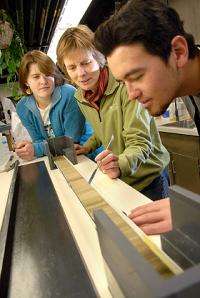Scientist uses sedimentary record to uncover planet's past

(PhysOrg.com) -- The wind barreled across the ice at Daily Lake as Montana State University paleoecologist Cathy Whitlock and three students used all their strength to pull a metal pipe out of the mucky lake bottom. With much effort, they hauled up 16,000 years of history from the glacial lake.
Daily Lake, north of Yellowstone National Park in the Paradise Valley, may be one of the oldest lakes in the Greater Yellowstone Ecosystem. About 25,000 years ago a glacier pushed its way north from what is now Yellowstone National Park, scraping the ground beneath it bare. As the glacier began to melt, the Daily Lake area was one of the first places to be exposed.
Whitlock is trying to figure out the succession of plants to colonize Yellowstone after the glacier retreated. Daily Lake would have been the first "stop" on the plants' way south and wind would have deposited their pollen into the lake, creating a record of the environment over thousands of years.
Whitlock's team, post-doc David McWethy, graduate student Teresa Krause and undergraduate Vincent Nagashima, retrieved cores spanning a 13.5-meter sediment column. They enclosed the cores in plastic wrap and aluminum foil and then labeled them for transport to Whitlock's MSU lab for analysis.
"Every lake that I core is different--the sediments have different colors, different layers and different transitions. I know that in those subtleties lie the secrets of its past," Whitlock said.
The pollen grains provide clues to when and what plants first arrived after ice recession and how the vegetation responded to subsequent climate change and human activities. The charcoal particles preserved in the sediment slices help identify past fires and changes in fire frequency over the millennia. Radiocarbon dating of organic material helps provide a chronology of past environmental change. By analyzing the records at many sites, Whitlock and her group can sleuth out how large and frequent fires were, how plant communities formed and changed, and how climate affected the ecosystem.
Whitlock has spent much of her career reconstructing vegetation and climate histories. Her research, described in over 100 scientific papers, examines how the climate changed past environments and shaped those we see today.
Current climate trends will likely bring deeper droughts and warmer winters to the Greater Yellowstone Ecosystem. Knowing how vegetation reacted to similar changes in the past can help land managers plan for the future.
Whitlock, a leader in the field of paleoecology, is also working in New Zealand.
Here she aims to understand how people shaped past and present fire regimes. Separating human influences from natural ones in North America is difficult because people have lived on the continent for thousands of years. By comparison, the human impact on New Zealand stands in sharp relief to the ecological history of the island: Polynesians only arrived 800 years ago.
"Almost as soon as people arrived in New Zealand, they started burning, and within about 50 years, we think that 40 percent of the forests were destroyed. Why this was done is not clear and much debated," said Whitlock.
Whitlock and McWethy have visited New Zealand three times in the past four years. The low amounts of charcoal in lake sediments deposited before human arrival on the island confirm that natural fires were rare in New Zealand.
"We are looking at the increase in charcoal in several lakes to determine the geographic pattern of human-set fires. We hope that the pattern will help explain why so much of New Zealand was burned so quickly," Whitlock said. "And, if we understand the geographic pattern of fires, perhaps we can also understand how early people viewed the landscape."
It appears the New Zealand vegetation did not evolve with fire.
"The native forests seem to have little resilience to this new type of disturbance. They rapidly unraveled when fire was introduced and were replaced with grasslands," Whitlock said. "Nutrients from the soil flushed into lakes from deforested slopes and the water chemistry changed from acidic to alkaline."
This in turn, probably affected everything that lived in the lake, from fish to plants to microorganisms.
"Realizing that human activities can lead to irreversible ecological change was a real 'ah-ha' moment for me," said Whitlock. "It's one thing to be told that humans are capable of changing the environment, but quite another to see the evidence of it in the sedimentary record."
While not an actual island like New Zealand, the Greater Yellowstone Ecosystem acts like an island. From 25,000 to 17,000 years ago, an ice sheet covered much of the area, and when it retreated it left a blank, desolate slate. Here,
Whitlock is asking how the Yellowstone ecosystem evolved. What were the controls--climate, geology, people or simply happenstance--that determined what grew where?
By looking at lake cores from places like Daily Lake and consulting with other scientists, Whitlock can reconstruct how Yellowstone went from post-ice-age nothingness to the landscape we see today.
For example, her research indicates an abrupt and widespread arrival of lodgepole pine in the northern Rockies 11,000 years ago. Just prior to that, one of Yellowstone's most common trees barely shows up in the climate record. As the present climate warms, Whitlock expects to see more lodgepole pines and at higher elevations.
Standing on the glassy surface of Daily Lake, with the wind seeping into every tiny opening in their clothing, Whitlock and crew lean into the corer and pull another piece of the climate puzzle from the lake.
"It is a great intellectual puzzle trying to figure out how an ecosystem evolves and also highly relevant for understanding ecological changes underway today and likely in the future," Whitlock said.
Provided by Montana State University




















